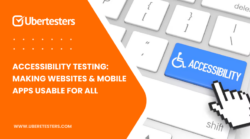Smoke Testing: Ensuring Stability and Reliability Through Crowd Testing

Ever wondered why software development teams prioritize smoke testing before launching their products? Picture this: you eagerly install a new app, only to have it fail each time you try to launch it. Annoying, isn’t it? Smoke testing (a.k.a. build verification testing or confidence testing) helps avoid such disappointing experiences by ensuring the core functionalities are working as expected. Before diving into more in-depth testing like regression, functional, integration, and more, smoke testing can help you save plenty of time and avoid major problems. The QA teams will move on to more extensive testing if the program passes the smoke test. If the software doesn't pass the smoke test, it's sent back to the developers. This vital process ensures that the product is both functional and stable. Still, what exactly does smoke testing in QA involve, and at what point during development is it carried out? Dive into the article to explore more!
What Is Smoke Testing? Its Importance in Software Development

What Is Smoke Testing
Smoke testing is designed to validate the fundamental functionality of software, concentrating on the business logic. This method of testing ensures that, after any changes, updates, or deployments, the system’s key functions are still operating properly. The primary purpose of smoke testing is to confirm that core features are functional before diving into more comprehensive testing phases. If we consider the E2E scenario of smoke examination for an E-commerce platform, the successful completion in this context would guarantee that users are able to choose products without any difficulties, add them to their shopping carts, and finish their purchases without facing any significant problems. To sum up:
- The process of finding software flaws or errors in their early phases.
- Determine whether the program is stable.
- Make sure that all features are operational.
- Verify that the software is carrying out its major functions as expected.
When to Perform Smoke Testing: Main Applications
Before learning how to do smoke testing, let’s look at some real-world applications. A smoke audit usually precedes more thorough testing or follows a build. It ensures that important functions work and the build is stable enough for further testing.
Acceptance Stage
When a new software build is passed over to the QA team, smoke testing is typically performed at the acceptance level. This type of software examination ensures that the core functions are working correctly and meet initial expectations. This check confirms that the build is stable enough for further, more in-depth research.
System Stage
At the system level, smoke testing is run subsequently to the system's independent check and prior to the implementation of a comprehensive regression test. Automated smoke testing is the most prevalent method at this stage.
Integration Stage
Smoke tests are performed at the integration testing level to guarantee that all of the cross-functional components are operating as expected. Plus, it’s necessary to find out whether the crucial integration processes are functioning properly.
Key Characteristics of Effective Smoke Testing

Effective Smoke Testing
Here are the essential traits of a smoke test plan:
- Automated & Repeatable: Smoke tests can be automated using scripts or tools. That is why specialists can run such checks consistently during key stages, such as builds, code commits, and deployments.
- Prioritized & Regularly Updated: Such examinations are focused on the most crucial features. Developers have to review these functions to ensure they remain relevant to the system's evolving needs.
- Fast Execution: Smoke tests run swiftly, offering immediate feedback on whether the software is stable enough to proceed with further checks.
- Clear Pass: Smoke tests deliver specific, accurate results. If any test fails, it means a significant issue popped up that needs an immediate solution before moving forward.
- Wide Scope: While each test might be narrowly focused, the collective suite ensures that critical areas such as user interface (UI), data processing, and integrations are covered.
- Short & Targeted: Smoke tests are brief, and focused on core functionalities. They quickly check for stability before a more detailed review.
- Independent from Detailed Requirements: This examination focuses on verifying basic functionality without delving into the specifics of comprehensive requirement documents.
Benefits of Smoke Testing in Software Development
The importance of smoke testing can be proven by its advantages.
Better testing efficiency
Using smoke testing in software testing will save the testing team time and work. It doesn't make sense to work on a build that is full of bugs and doesn't work very well. People like to use smoke tests to find all kinds of problems because of this. They can then get rid of them early, making sure that each new release in agile software development, which builds on the last, has a solid, bug-free base. To put it another way, smoke tests make the core code more reliable. Additionally, they make it easier to add new builds because they are less likely to have major issues.
Faster bug troubleshooting
Thanks to smoke testing, developers can immediately jump into debugging and investigate the root cause of the occurred problems. They don’t even have to wait for the full test suite. This is possible because smoke tests provide initial coverage though no in-depth research is carried out. This exam allows for quick identification of critical flaws. After fixing defects found by quality assurance (QA) during regression testing, developers can address any remaining bugs.
Time and Resource Efficiency
A QA smoke test typically lasts between 15 minutes to 2 hours, depending on the system's complexity. By identifying issues early and accurately, teams save time by reducing the need to search through code for problem areas. Automating smoke tests further enhances efficiency, enabling teams to quickly pinpoint problems and focus on fixes rather than extensive troubleshooting. This not only saves time but also cuts costs, especially for teams that haven’t fully adopted automation yet. Automation can streamline the entire smoke testing process, as explained in the following section.
Mitigation of risks associated with integration
It is usual to use CI/CD tools and processes for integrations that add new features to an existing software application. Smoke testing is useful for these types of integrations. These features are added in fresh builds, and every build has to be tested before it can be utilized. If smoke testing is a part of the testing process, you may be certain that the entire integrated software has been tested.
Boost in job satisfaction
If they are able to go forward with their work rather than being continually delayed by big system faults, testers will experience increased happiness and decreased stress. Developers will also experience less stress if they are able to repair defects in a timely manner without being under pressure to meet deadlines that are rapidly approaching. As a general rule, contented workers perform their duties more effectively, which in turn has an effect on the effectiveness of the project.
Enhanced team confidence
When there are frequent releases, regular smoke tests also give developers and other stakeholders faith in the stability of the product, especially when it comes to core functions. Because they are sure, they don't need to do a lot of testing at some times, like when the current build doesn't change much from the last one.
Why Combine Smoke Testing with Crowd Testing?

Combining smoke testing with crowd-testing offers several significant benefits, such as stability and reliability through crowd-testing. That allows enhancing the software development process. Smoke testing ensures that the core functions of a product are working before deeper testing, while crowd testing adds diverse perspectives from real users.
- Diverse perspectives: Crowd testing brings together testers from different backgrounds, devices, and environments, offering insights that in-house teams may overlook.
- Faster detection of critical issues: With multiple testers working simultaneously, crowd testing allows for quicker identification of major bugs, complementing the initial stability checks of smoke testing.
- Real-world testing scenarios: Crowd testing mimics real user environments, ensuring the software works under practical conditions beyond controlled lab setups.
- Scalability: Smoke testing combined with crowd testing is highly scalable, allowing teams to test across multiple devices and regions quickly.
- Cost-effectiveness and efficiency: Crowd testing is often more affordable and efficient, leveraging external testers without the need for extensive in-house resources.
- Improved user experience focus: The diverse feedback from real-world users helps teams align the product with user expectations, leading to a better overall user experience.
Now, it’s time to find out how to perform a smoke test in several simple steps.
Steps to implement crowd-sourced smoke testing
Crowd-sourced smoke testing methods ensure robust, user-friendly software that functions effectively in real-world environments. Here is how to implement those testing best practices:
- Select the right crowd-testing platform.
- Define clear objectives and test cases/scenarios.
- Pick effective communication channels with the crowd-testing company for better engagement and management of the crowd-testers.
- Collect and analyze feedback.
- Act further based on the test results.
Conclusion
In conclusion, combining smoke testing with crowd testing offers significant advantages, such as faster issue detection, diverse insights, and real-world scenario validation. This integrated approach ensures software stability and reliability by addressing both initial functionality checks and user experience feedback. Companies adopting this strategy can achieve more efficient, scalable testing processes, ultimately improving product quality. Embracing this combination not only enhances testing efficiency but also drives a more user-centered development process, ensuring that the final product meets real-world demands. It’s up to you whether to conduct manual smoke testing or use special platforms and teams to assist you. Looking to dive deeper into the benefits of crowd-testing? Want to use Ubertesters for your smoke testing? Reach out to us at sales@ubertesters.com for an in-depth exploration.

